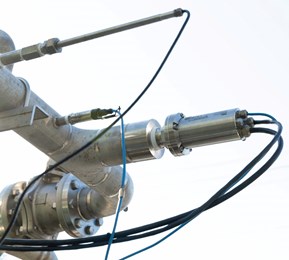New technology enables the green transition away from natural gas
Countries around the world are urgently seeking alternatives to fossil fuels to lower greenhouse gas (GHG) emissions and thereby limit global warming. One of the ways in which this can be achieved is by replacing natural gas with biomethane, but this can only be a viable solution if it is environmentally and financially sustainable. To achieve this goal, it is necessary to monitor biogas production continuously so that the process can be optimized. The author’s company has developed monitors that are capable of measuring methane (CH4), carbon dioxide (CO2) and humidity in-line (FIG. 1).
 |
| FIG. 1. Vaisala’s inline multigas probe provides 24/7 data that enables process optimization. |
Formed over a timespan of millions of years when layers of organic matter decompose deep underground at high temperature and pressure, natural gas consists of CH4 and small amounts of other gaseous hydrocarbons. Natural gas is, therefore, a fossil fuel—its combustion is responsible for a significant portion of global GHG emissions. For example, according to the U.S. Environmental Protection Agency (EPA), emissions from natural gas consumption represented 79% of the direct fossil fuel CO2 emissions from the U.S. residential and commercial sectors in 2020.
Spiralling energy costs, supply chain disruption and the GHG emissions associated with the extraction, transport and combustion of natural gas mean that cheaper, reliable and more sustainable alternatives to natural gas are required.
As fossil fuels are phased out during the green transition, it has become necessary to find alternative sources of clean energy through innovation. New technology has a vital role to play as the world moves into a profitable and sustainable era of green energy.
Replacing natural gas with biomethane. Biogas represents an important green alternative, but only if it is economically viable and able to compete with alternative forms of renewable energy. In-line monitoring of biogas production and the upgrading process to biomethane enable significant production efficiency improvements, making biomethane an economically and environmentally viable alternative to fossil fuels.
Some 75% of the biogas now produced in the European Union (EU) is used as a source of local heat and power generation, with almost 20% of biogas being converted to biomethane. According to the European Commission’s RePowerEU scheme, biomethane production is projected to increase tenfold by 2030 and to grow even more rapidly to 2050. Today, the production cost of biomethane has been estimated to be around €80/MWh, but the European Biogas Association expects this to fall to €55/MWh in the future. These increases in both production and efficiency can only be achieved with the latest technology in process control instrumentation.
Biogas also offers an opportunity for a more circular economy. This is because the feedstock for anaerobic digestion (AD) can include waste products—such as food, crop residues, animal manure and wastewater sludge—and the digestate from AD can be returned to the land as fertilizer.
Reducing CH4 slip. Biogas represents an attractive opportunity, but its sustainability credentials would be damaged if CH4 is allowed to slip into the atmosphere from either the AD reactor or the gas upgrading process. This is particularly important because CH4 is a powerful GHG—roughly 30 times stronger than CO2—so it is vital that advanced monitoring and process optimization are employed to lower or prevent any potential emissions.
Renewable energy solutions. Biomethane is a useful alternative where a gas fuel must be used, or where natural gas is used as a feedstock rather than a fuel. In the chemical industry, for example, natural gas is used as an energy source, and as a raw material for the production of ammonia, which, in turn, is used to produce fertilizers.
Substantial infrastructure is in place to facilitate the utilization of natural gas, so biomethane represents a logical alternative. However, there will be many instances where fossil fuel energy sources can be replaced by other forms of renewable energy, such as wind and solar. Biomethane production must, therefore, be as efficient as possible if it is to compete, and this is where the latest monitoring technology can perform a vital role. GP
 |
Antti Heikkilä is an industry expert and Product Manager at Vaisala, where he leads bringing Vaisala’s ground-breaking and sustainable innovations for biogas measurement to market.




Comments